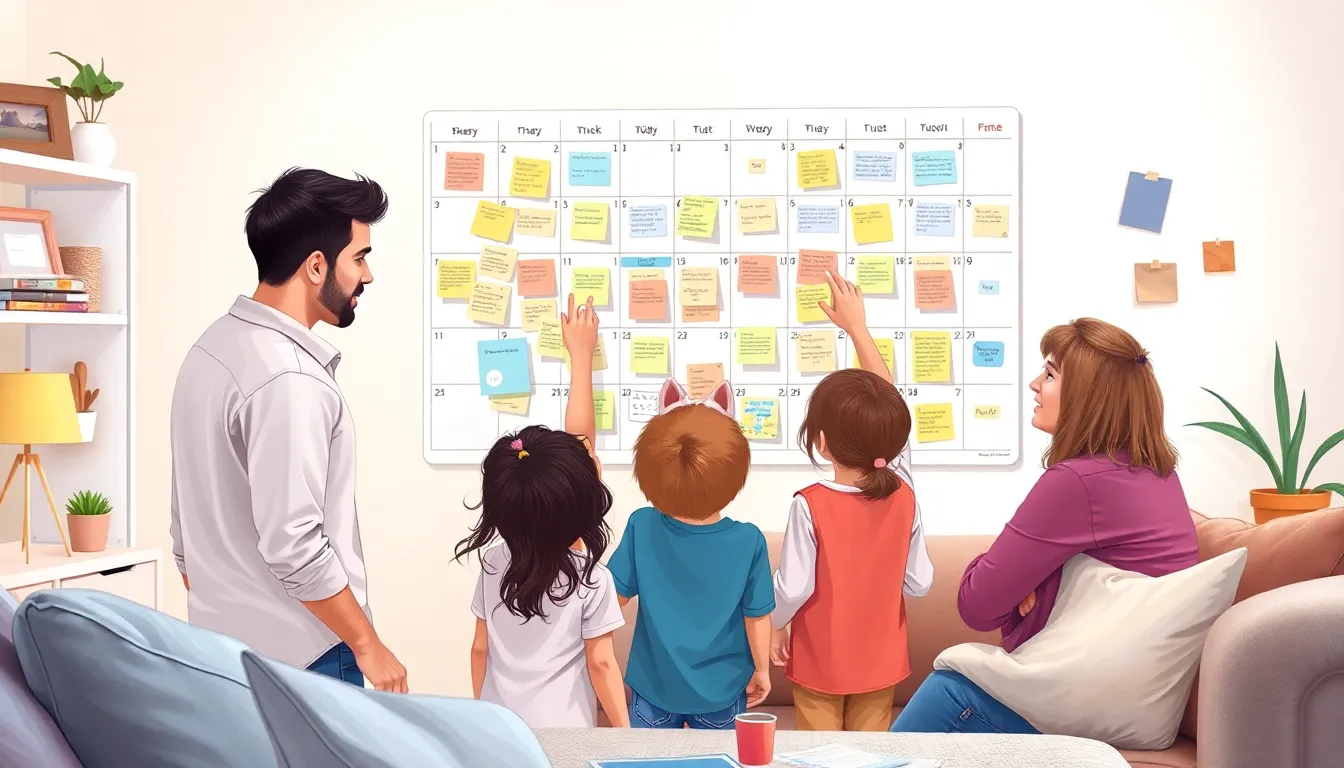In today’s whirlwind of activities, juggling family life can feel like a circus act gone wrong. Between school drop-offs, work commitments, and the never-ending quest for matching socks, chaos often reigns supreme. But what if there’s a way to turn that chaotic three-ring circus into a well-rehearsed performance? Enter the organized family routine—a game changer that can transform even the most hectic households into smooth-running operations.
Imagine a world where everyone knows their role, and dinner doesn’t resemble a game of culinary roulette. An organized routine not only saves time but also reduces stress, making family life more enjoyable. With a sprinkle of planning and a dash of flexibility, families can reclaim their sanity and maybe even find time for that elusive family game night. So, let’s dive into the art of creating a routine that brings harmony to the family chaos.
Table of Contents
ToggleImportance Of An Organized Family Routine
An organized family routine plays a crucial role in enhancing family dynamics. It streamlines daily activities and fosters a sense of stability for every family member.
Benefits For Children
Structured routines offer numerous advantages for children. They promote better time management skills, allowing kids to prioritize tasks effectively. Regular schedules contribute to a sense of security, helping children understand expectations. Children with organized routines often experience improved academic performance due to dedicated homework time. Additionally, routines encourage healthy habits, such as consistent meal times and sleep schedules, which support overall well-being. Finally, engaging in family activities during set times nurtures stronger family bonds.
Benefits For Parents
Parents also gain significant benefits from an organized family routine. It reduces stress by eliminating daily decision fatigue, allowing more mental clarity. Time-blocking tasks helps parents maintain a steady flow of household responsibilities, leading to increased productivity. Consistency in routines fosters cooperation from children, making parenting easier. Parents can enjoy more quality time with their children when evenings are structured around family activities. Ultimately, a clear routine enhances overall family satisfaction, creating a harmonious home environment.
Key Elements Of An Organized Family Routine
An organized family routine includes several key elements that enhance daily life. These components contribute to a structured environment that promotes harmony and bonding among family members.
Consistent Meal Times
Consistent meal times establish predictability in daily schedules. Families who sit down for breakfast, lunch, and dinner at the same times foster togetherness and communication. This routine nourishes not just the body but also the family’s relationships. Regularly sharing meals can create opportunities for conversations that strengthen family ties. Setting specific times helps children learn time management while ensuring healthy eating habits.
Designated Family Time
Designating specific family time enhances connections among members. Setting aside time for activities like game nights or movie evenings encourages interaction and shared experiences. All family members benefit from this structure, as it reinforces the importance of spending quality time together. Prioritizing family activities nurtures a sense of belonging and support. Scheduling these moments reduces the likelihood of conflicts and ensures everyone feels included in family life.
Homework and Chores
Incorporating homework and chores into the routine promotes responsibility and teamwork. Assigning specific times for homework helps children develop effective study habits. Using chore charts can assign tasks fairly and make participation more engaging. Families who work together on household tasks strengthen their collaborative skills. Creating this structure allows for accountability and teaches children the value of contributions within a family.
Creating An Effective Organized Family Routine
Creating an organized family routine involves familiarity with each family member’s needs and preferences. This awareness sets the foundation for a structured environment that works for everyone involved.
Assessing Family Needs
Identifying specific family needs lays the groundwork for a proper routine. Families can start by discussing daily schedules, responsibilities, and personal commitments. Gathering input from each member aids in understanding priorities and challenges. It’s essential to evaluate how much time activities require, from schoolwork to household chores. This knowledge helps in crafting a personalized routine that meets everyone’s needs effectively.
Establishing Clear Expectations
Clear expectations prevent misunderstandings within a family routine. Families should outline responsibilities, such as who prepares meals and manages clean-up duties. Designating specific times for homework and other activities retains consistency. Additionally, discussing the consequences of not meeting these expectations fosters accountability. Regular check-ins to revisit and adjust these expectations ensure everyone stays on track and aligned with the routine.
Involving Family Members
Involving family members promotes ownership of the routine. Families can hold meetings to discuss proposed schedules, encouraging every member to express their thoughts and preferences. This collaborative approach boosts morale and commitment to the routine. Assigning roles based on individual strengths contributes to a balanced workload. Celebrating achievements together reinforces positive behavior and maintains enthusiasm for the organized family routine.
Tips For Maintaining An Organized Family Routine
Maintaining an organized family routine requires ongoing effort and commitment. Families can adopt a few key strategies to ensure smooth operations.
Flexibility And Adaptability
Flexibility within the routine accommodates unexpected events and changes. Families can adjust meal times or activities when necessary, ensuring stress levels remain low. Adapting to situations, like a child’s late school project, prevents chaos from disrupting the entire schedule. Children learn the importance of being adaptable, fostering resilience in daily life. An organized routine becomes a foundation for stability, even amid unpredictability.
Regular Check-Ins
Regular check-ins facilitate communication about the routine’s effectiveness. Families can set aside time weekly to discuss what’s working and what isn’t, making adjustments as needed. Engaging everyone in these discussions motivates commitment and ensures all voices are heard. Active participation reinforces accountability and helps identify potential issues before they escalate. Continuous dialogue keeps the family dynamic strong and the routine relevant.
Celebrating Successes
Celebrating successes emphasizes the family’s progress and fosters a positive atmosphere. Acknowledging small achievements, like completing chores on schedule, boosts morale. Families can create special moments, such as a family outing or a treat, to reward consistent efforts. Celebrating successes cultivates a sense of teamwork and accomplishment, driving motivation for future cooperation. This shared joy strengthens family bonds and reinforces the importance of maintaining an organized routine.
Conclusion
An organized family routine can significantly transform daily life. By embracing structure families can cultivate a sense of stability and connection. This approach not only enhances individual well-being but also strengthens family bonds.
With clear expectations and shared responsibilities everyone can contribute to a harmonious environment. Flexibility remains essential allowing families to adapt to life’s unpredictability.
Ultimately establishing a routine isn’t just about managing time; it’s about creating lasting memories and nurturing relationships. Families that prioritize this practice often find themselves enjoying more quality moments together.






